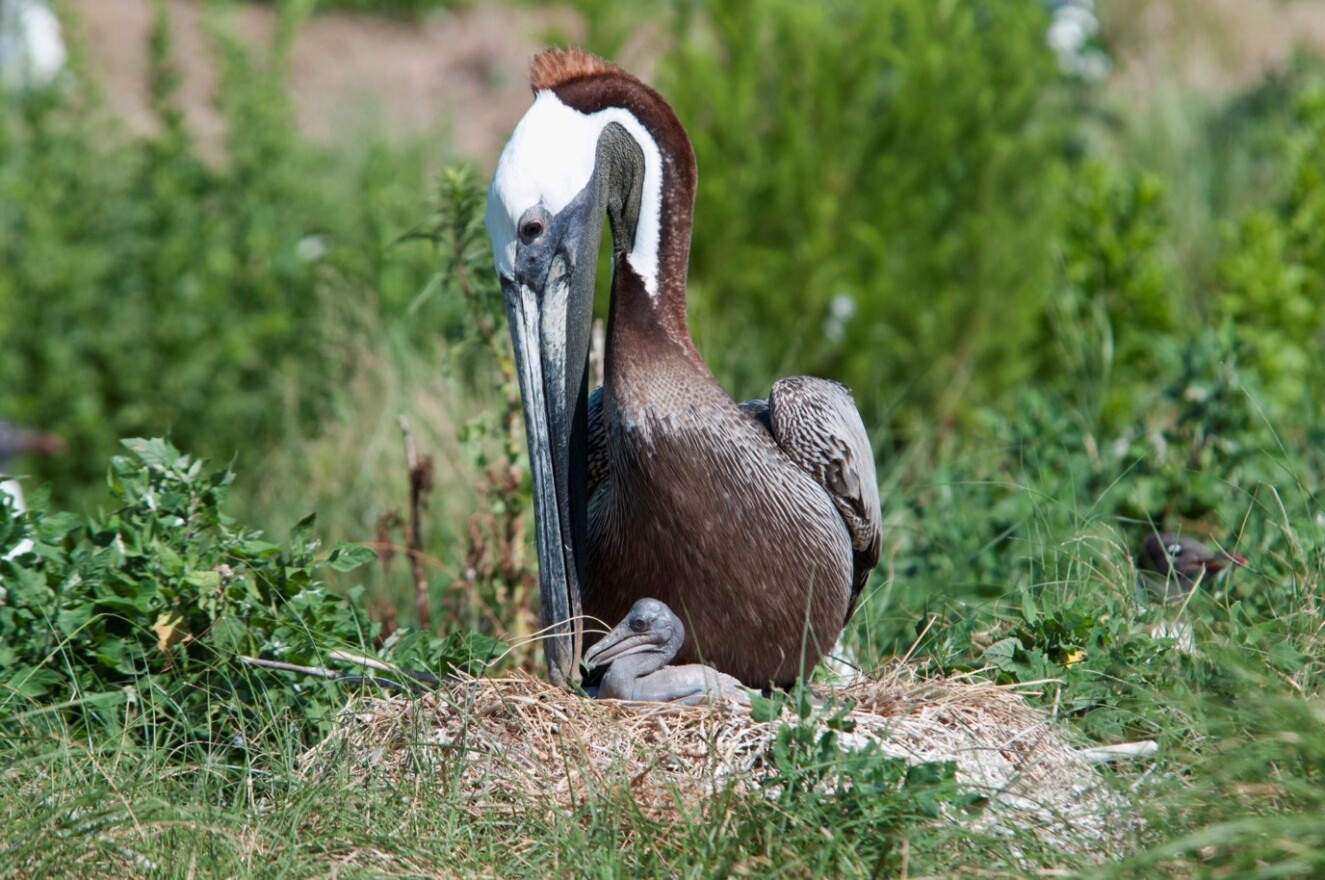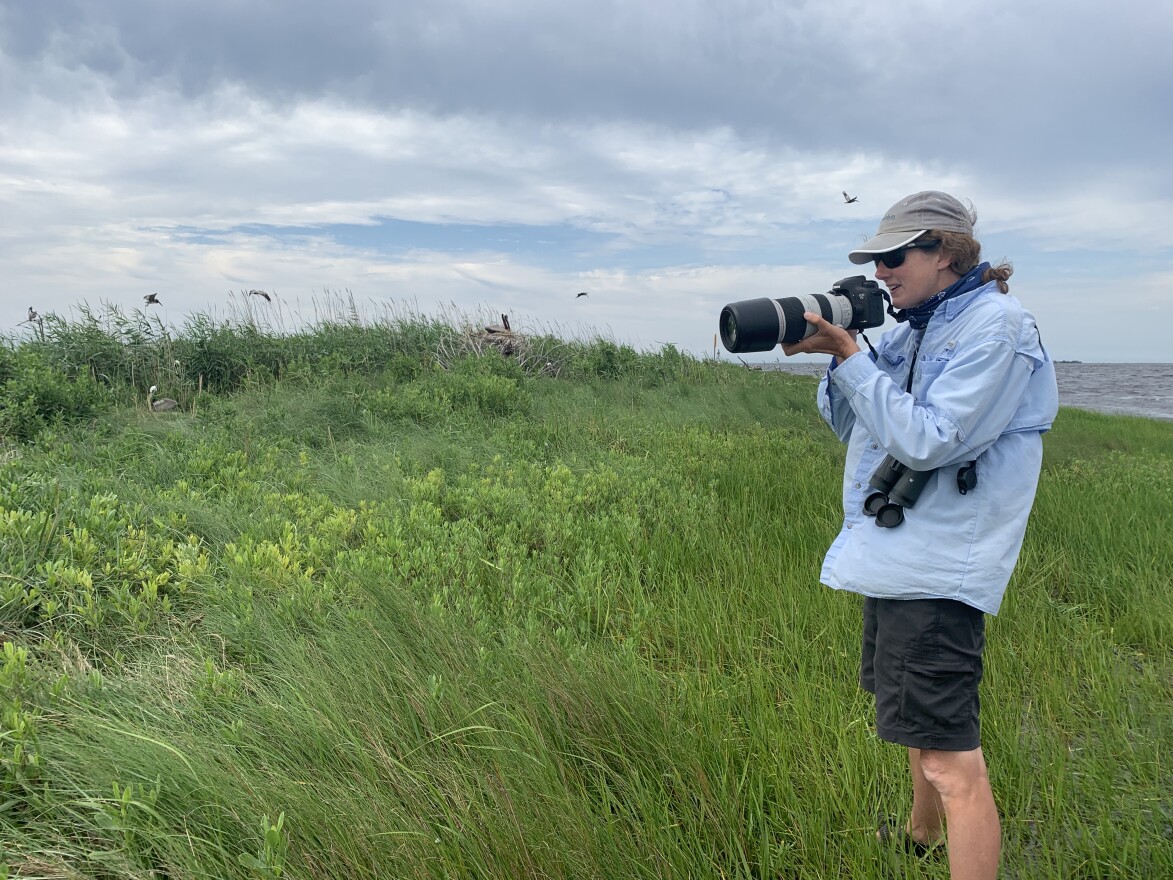Fifty years ago, the insecticide DDT nearly wiped out pelicans. Today, four- to five-thousand pairs nest in North Carolina – about a quarter of them on marshy, low-lying spoil islands in the Cape Fear River. It’s part of the pelican life cycle beachgoers never see.
But WHQR got an up-close view after hopping a boat with an Audubon North Carolina Coastal Biologist.
[sound of boat motor, water lapping]
Lindsay Addison has taken us south from Snows Cut down the Lower Cape Fear River. We’re looking at a congregation of Great Egrets sharing an island made of dredged material with a pelican colony.
Dozens of nesting brown pelicans, the kind native to North Carolina, are soaring overhead. Many more are sitting on nests.
It’s other-worldly.
"They make a fairly large nest out of sticks and dead marsh grass. The male typically brings in the nesting material and the female constructs the nest, and the nest is over a foot in diameter. And in that nest, they lay 2-3 eggs."
[pelican sounds]
Addison explains that once the eggs hatch, the mother and father share parenting duties. Brooding, sitting on the chicks, helps regulate the chicks’ body temperature—whether that means shading them from the hot sun or keeping them warm on a cool morning – they need help until their own white, fluffy down grows in, and later, their first adult feathers.
[BABY PELICANS CHIRPING]
From the boat at the edge of the island, we can see nests with chicks of varying ages.
We get out of the boat, walk onto the island, passing multiple nests with just two eggs. Of those two eggs, which look slightly larger than duck eggs, it's likely only one chick will survive.
Then we spot a nest holding a single baby pelican. The parent has flown away.
[baby pelican cries]
This newly-hatched chick looks like a tiny version of a rotisserie chicken. The baby’s skin is bare and while her back is to us, she stretches her head around to see us – squawking at us, warning us away.
What we’re doing right now is one of two major threats pelicans face.
"If your presence is making the parents leave the nest of the chicks, that exposes them to a lot of threats, especially temperature stress, but also things like predation by crows. Those are certainly voracious predators… Do not land on the islands during the nesting season which is March through August – is really critical for their survival."
It’s a careful bargain biologists make with the birds. They’ll intrude on the colony once a year or so in exchange for data. And they’ll only do it when temperatures are moderate -- so the chicks can survive without a parent for a short time.
For anyone else, harassing or disturbing the birds is illegal.
On these low-lying islands, they’re safe from predatory mammals like foxes, raccoons and coyotes. But there’s another primary threat: inundation.
"If you’re a bird that has a nest just about maybe a foot above mean high water – and a huge ship wake comes past you at high tide, putting another few inches onto the island -- that could wash out your nest."
Sea level rise increases the threat from inundation.
That’s one reason nature rewards those who start nesting early: pelicans will only raise one brood per season, so if a nest does fail the bird couple might have time to try again.
Addison says she’s seen some pelicans fledge as late as September.
There’s another asset pelicans need to survive.
"There’s a steep learning curve to being a pelican. You have got to become an incredible athlete and plunge-dive for fish… and they have an instinct for it, but there’s also a learning process to become proficient at it."
Every three years, Audubon North Carolina, the North Carolina Wildlife Resources Commission, and other partners, count colonial water bird nests in the state to spot trends and detect any problems early. This is one of those years -- and by late summer or early fall, we’ll know how well this squadron of pelicans is learning the lessons of survival.
Copyright 2021 WHQR. To see more, visit WHQR. 9(MDAxNzg0MDExMDEyMTYyMjc1MDE3NGVmMw004))






